
Survey Logic: How to Make Your Surveys Smarter and Faster
Ever started a survey and wondered, “Why am I answering questions that don’t apply to me?”. That’s exactly what survey logic prevents.
By adapting questions based on each respondent’s answers, survey logic transforms long, generic surveys into personalized conversations. It boosts engagement, reduces fatigue, and captures cleaner, more relevant data.
In today’s world, where users expect everything to be customized, conditional survey design isn’t just a nice touch; it’s essential.
This guide dives into the what, why, and how of survey logic, with practical survey logic examples like skip, branching, display, piping, and quota logic. The article also covers how to implement them, where they work best, and how tools like Polling.com make it easy.
What Is Survey Logic?
Let’s first learn about the definition and purpose of survey logic and why it matters in modern surveying.
Definition and Purpose
Survey logic is the engine behind responsive surveys. It dynamically tailors each user’s path through a survey based on their inputs, so every question feels relevant and timely.
For instance, in a customer satisfaction survey, logic can skip over questions about advanced features if a user says they’ve never used them. That means a faster, smoother experience—and better data for you.
By eliminating irrelevant questions, survey logic helps respondents stay focused and finish the survey, improving your completion rates and reducing drop-off.
Why It Matters in Modern Surveying
Today’s users expect digital experiences to adapt to them, not the other way around.
Survey logic delivers that adaptability by customizing each step of the journey. The benefits?
- Saves time: Respondents skip what doesn’t apply.
- Reduces fatigue: Shorter, more relevant surveys mean fewer abandonments.
- Improves accuracy: Cleaner, more targeted data without noise from irrelevant answers.
In short, survey logic keeps your survey smart and your data sharp.
Deep Dive into Types of Survey Logic
Let’s explore the most common survey logic types in action.
Skip Logic
Question skip logic lets you direct respondents to a different question, or skip sections entirely, based on their answers. It’s especially useful for screening or segmenting users.
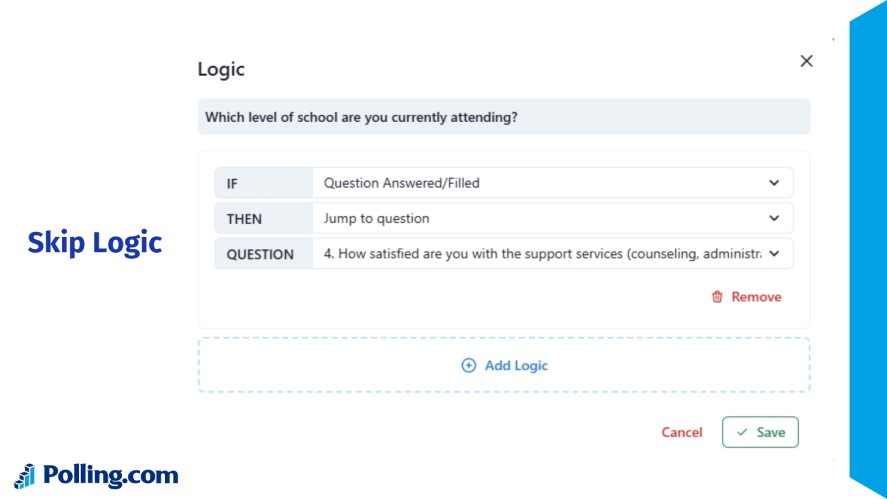
Example: “Do you use our mobile app?”
- If Yes → Continue with app-related questions.
- If No → Skip to next relevant section.
This type of logic prevents users from wasting time on questions that don’t apply to them. It’s best used for eligibility screening, product usage filters, and segmenting audiences.
Branching Logic
Branching logic takes things a step further by sending respondents down entirely different paths depending on their choices. This creates tailored experiences for different user types.
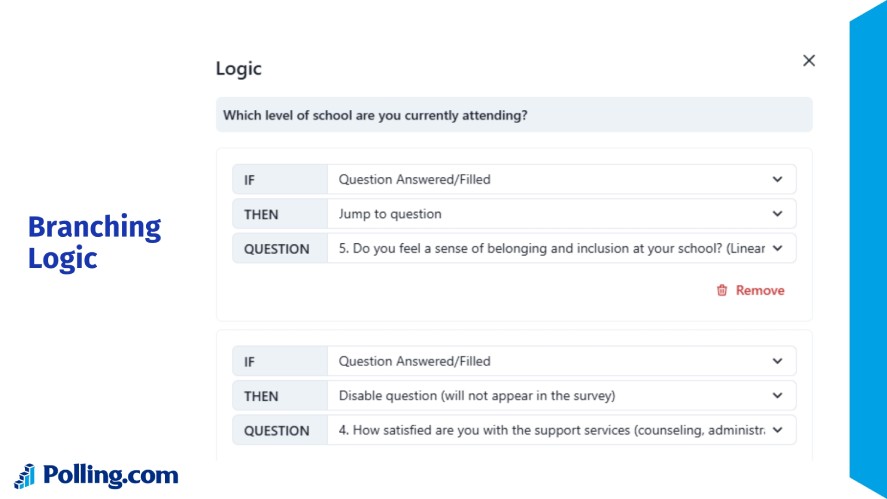
Example: In an employee feedback survey:
- Selecting “Marketing” loads a specific set of questions
- Selecting “Engineering” shows a completely different one
This logic is ideal for role-based assessments, B2B market segmentation, and industry or region-specific surveys.
Display Logic
Display logic hides or shows specific questions based on previous answers. It’s more granular than skip or branching logic and keeps things tightly focused.
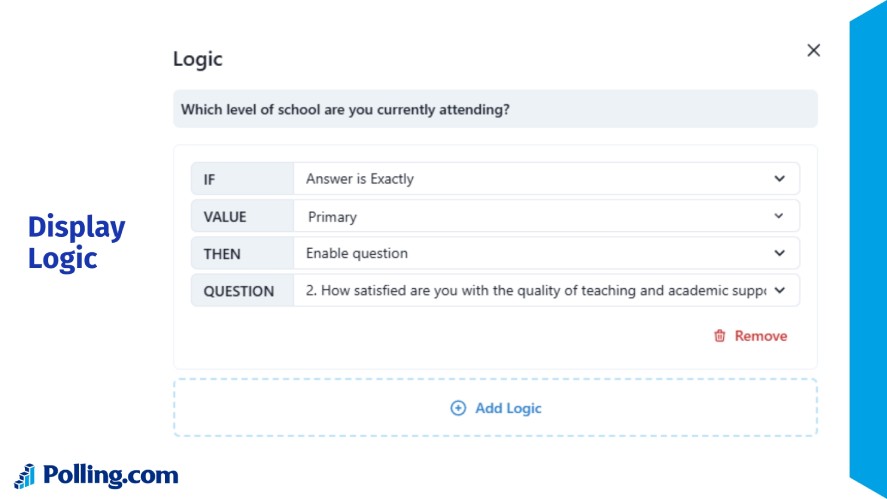
Example: If someone rates your product 2 out of 5, show: “What didn’t work for you?”. But if they rated it 4 or 5, skip that follow-up question.
It keeps surveys tidy and makes follow-up questions feel relevant, not repetitive.
Question & Answer Piping
Piping takes personalization even further by inserting a respondent’s earlier answer into a later question.
Example: If someone says they’re a teacher, the survey might ask: “As a teacher, what tools do you find most useful?”.
This kind of personalization keeps users engaged and makes the survey feel like a conversation, not a form.
Quota Logic
Quota logic manages how many responses you collect from each group to ensure balance and avoid skewed results.
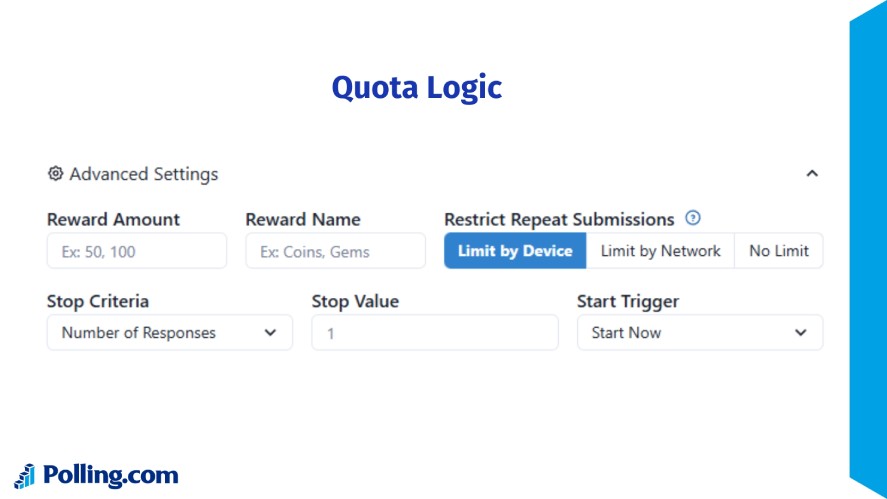
Example: Cap responses at:
- 200 from users aged 18–24
- 200 from users aged 25–34
- …and so on
This logic is common in market research, ensuring your sample is representative, especially in research surveys where even distribution matters.
Logic Actions in Surveys — What Can Survey Logic Do?
Survey logic isn’t just about skipping questions; it unlocks dynamic question paths that tailor the experience to each respondent.
Here’s a breakdown of what survey logic can do, complete with real-world use cases and how Polling.com supports each.
1. Skip to Question or Section
- Action: Bypass specific questions based on previous responses, jumping ahead in the survey.
- Use Case: If a user answers “No” to “Do you have a pet?”, skip all pet-related questions and go straight to the next relevant section.
- Available in Polling.com? ✅ Yes — easily applied using the drag-and-drop logic builder.
2. Show/Hide Questions (Display Logic)
- Action: Display or hide a question depending on how someone answered earlier.
- Use Case: If someone selects “Other” in a multiple-choice question, trigger a text box asking them to elaborate.
- Bonus: Keeps surveys clean and focused, showing only what matters.
- Available in Polling.com? ✅ Yes — quick to configure directly in the question settings.
3. Route to Different Survey Paths (Branching)
- Action: Send respondents down different routes based on their answers.
- Use Case: In an employee survey, respondents who select “HR” might get a different question set than those in “Engineering” or “Management”.
- Available in Polling.com? ✅ Yes — visual flow builder makes branching logic simple to manage.
4. End Survey Early (Disqualification Logic)
- Action: Exit the survey early based on eligibility criteria.
- Use Case: If a respondent is under 18 in a survey meant for adults, redirect them to a custom end screen with a thank-you note or alternate link.
- Available in Polling.com? ✅ Yes — disqualification logic and custom redirects are built in.
5. Pipe Answers Into Future Questions (Answer Piping)
- Action: Reuse a respondent’s earlier answer in later questions to personalize the experience.
- Use Case: If a respondent selects “Slack” as a tool they use, a later question can ask: “How satisfied are you with Slack?”.
- Available in Polling.com? ✅ Yes — supports piping across most question types.
6. Redirect to External Links or URLs
- Action: Guide users to an external page based on how they answered.
- Use Case: After submitting a lead-gen survey, respondents can be redirected to a landing page with a product offer.
- Available in Polling.com? ✅ Yes — fully customizable end-screen logic and URL redirects.
7. Apply Quota Logic
- Action: Limit how many responses are accepted for certain categories.
- Use Case: Cap responses from a specific age group or region to ensure balanced representation in market research.
- Available in Polling.com? ❌ No.
8. Trigger Notifications or Emails
- Action: Send automated email alerts based on survey responses.
- Use Case: If someone gives a low Net Promoter Score, notify your customer support team instantly.
- Available in Polling.com? ❌ No.
Summary of Actions Table
| Logic Action | Description | Example Use Case | Available in Polling.com? |
|---|---|---|---|
| Skip to Section | Jumps ahead to relevant questions | Skip car questions if respondent doesn’t drive | ✅ |
| Show/Hide Question | Conditionally displays questions | Show text field for “Other” choice | ✅ |
| Branch to New Path | Splits survey into unique tracks | Role-specific employee questions | ✅ |
| End Survey Early | Disqualifies or finishes survey based on input | Underage screening for age-restricted surveys | ✅ |
| Answer Piping | Uses answers in later questions | Personalizing follow-up questions | ✅ |
| Redirect to URL | Sends users to a custom link | Redirect to thank-you page or resource | ✅ |
| Quota Capping | Limits response volume per category | Cap 100 responses per demographic group | ❌ |
| Trigger Email Notification | Sends alerts based on answers | Notify team if NPS is low | ❌ |
Benefits of Smart Survey Logic
Smart survey logic transforms a one-size-fits-all questionnaire into a dynamic, user-focused experience.
It helps you ask the right questions, to the right people, at exactly the right time, maximizing both engagement and insight.
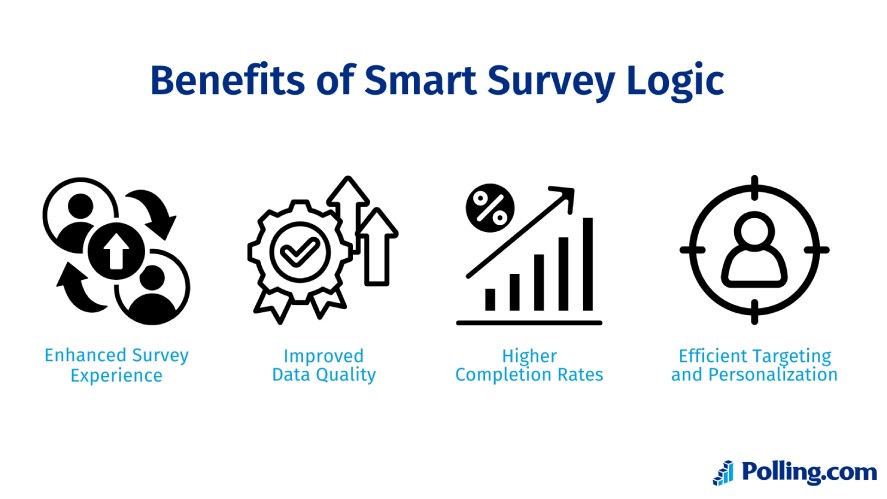
Enhanced Survey Experience
Respondents no longer have to slog through irrelevant or redundant questions.
With survey logic, each question feels tailored to their experience, making the process feel more like a conversation than a form. This keeps engagement high and frustration low, especially in longer surveys.
Improved Data Quality
When respondents only see questions that apply to them, the result, even in an anonymous feedback survey, is cleaner, more meaningful data.
You’ll avoid “N/A” answers, reduce guesswork, and ensure segmented analysis is more accurate and actionable.
Higher Completion Rates
Logic-powered surveys tend to be shorter, more relevant, and less repetitive. These are the three factors that significantly reduce drop-off rates.
By eliminating fatigue and friction, you keep users moving smoothly through the survey until the end.
Efficient Targeting and Personalization
Whether you’re surveying new customers, long-time users, or different buyer personas, logic allows you to customize their path.
You can tailor the flow based on roles, demographics, behaviors, or even previous answers, making one survey feel uniquely personal to each user.
Survey Logic in Action: Polling.com
Survey logic sounds powerful in theory, but how does it play out in real tools?
Polling.com is built from the ground up to make smart survey logic easy, even for beginners.
Why Use Polling.com for Survey Logic?
Polling.com stands out with its intuitive interface and powerful logic builder. Its drag-and-drop design makes setting up skip logic, branching, and answer piping effortless, even if you’ve never used advanced survey tools before.
You also get real-time previews and path validation, so you can instantly test and fix any broken logic before launching.
Plus, unlike many platforms, Polling.com offers unlimited questions (even on the free plan) ,giving you more room to create detailed, personalized surveys without restrictions.
Step-by-Step: Building a Smart Survey on Polling.com
Creating a logic-powered survey with Polling.com takes just a few steps:
- Choose your question type: multiple choice, rating scale, open-ended, and more.
- Add logic: access the logic panel to apply skip or branching conditions.
- Preview and test: simulate different responses to confirm logic behaves as expected.
- Launch and analyze: distribute surveys and track responses using Polling.com’s built-in analytics tools.
Comparison: Polling.com vs SurveyMonkey, Typeform, and Google Forms
When it comes to flexibility and usability, Polling.com has a clear edge:
| Tool | Comparison |
|---|---|
| Polling.com | Best for logic design with an intuitive drag-and-drop interface, unlimited logic paths, and free-tier access to all question types. |
| SurveyMonkey | Rich features but locks most logic tools behind premium plans. |
| Typeform | Visually polished and user-friendly but can be restrictive for advanced branching or complex surveys. |
| Google Forms | Easy to use and free but limited to basic skip logic and lacks piping or branching features. |
While some platforms restrict access to logic tools behind paywalls, Polling.com is one of the best free survey tools for nonprofits looking to design responsive, logic-driven surveys without the overhead.
Advanced Tips for Designing with Survey Logic
Designing conditional logic forms isn’t just about adding conditions; it’s about planning for clarity, usability, and performance.
These advanced tips help you make the most of survey logic while keeping things clean and scalable.
Map Your Logic Before Building
Before you even open your survey tool, sketch out your logic flow.
Use a visual diagram or flowchart to plot out all possible paths a respondent might take. This prevents dead ends, duplicate paths, and confusing overlaps later in the process.
Keep It Simple
Just because you can create multiple branches doesn’t mean you should.
Only use logic where it meaningfully improves the survey experience. Too much complexity can confuse respondents and make your survey harder to maintain.
Label Logic Clearly
As your logic tree grows, it’s easy to lose track of what each condition does. Label each rule, condition, and path clearly within your survey tool.
Not only does this help with your own organization, but it also improves collaboration with your team, especially when you return to edit or optimize the survey later.
Preview and Test All Paths
Testing is critical. So, don’t assume your logic works as intended. You need to simulate different scenarios and test every possible path a respondent might take.
If your audience is mobile-first, test on real devices to make sure logic behaves correctly across screen sizes and platforms.
Common Mistakes and How to Avoid Them
Even with the best intentions, it’s easy to fall into traps when using advanced logic in surveys.
Here are some of the most common mistakes in survey logic and how to avoid them.
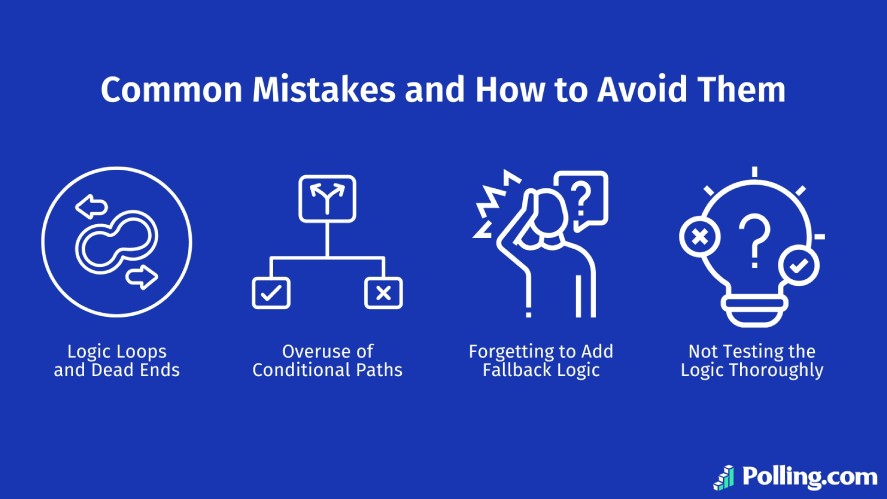
Logic Loops and Dead Ends
One misconfigured condition can send users in a loop or drop them at a dead-end question with no way forward.
So, always double-check that every response has a clear, logical next step.
Overuse of Conditional Branching and Paths
Logic is powerful, but when overused, it creates a tangled web that’s hard to manage and frustrating for respondents.
Stick to key divergence points where personalization matters most, like different flows for user roles or product tiers.
Forgetting to Add Fallback Logic
Not every respondent will give a clear or expected answer.
So, always define default behaviors for edge cases, such as “None of the above” or blank responses. This ensures your survey still completes gracefully.
Not Testing the Logic Thoroughly
Skipping final testing is a recipe for broken surveys. Even a small error in a skip condition can derail the experience and leave you with incomplete or inaccurate data.
Always walk through multiple test cases, or better yet, have someone unfamiliar with the logic test it for fresh perspective.
Real-World Applications of Survey Logic
Survey logic isn’t just a technical add-on; it powers smarter, more targeted experiences across a range of industries.
Here’s how it plays out in real-world scenarios.
Market Research Surveys
Logic can filter participants based on behaviors like purchase history, product usage, or location.
This ensures that questions are only shown to respondents who meet the right criteria, keeping your insights sharp and relevant.
Political Polling
Branching logic allows pollsters to route respondents down different paths depending on political affiliation, voter registration status, or past voting behavior.
This keeps responses focused and increases accuracy in segmented analysis.
Employee Engagement Surveys
In HR and internal surveys, logic can trigger department-specific questions, like asking engineers about tooling and marketers about collaboration.
This personalization improves response quality and makes feedback more actionable.
Customer Feedback Surveys
Survey logic is especially powerful when distinguishing between new and returning users.
While new users might be asked about onboarding, long-time users can be prompted for feedback on advanced features, leading to more insightful results.
Whether you’re launching a product or testing an idea, a simple please survey message sent to your user base, paired with smart logic, can make all the difference in response rate and quality.
How Survey Logic Impacts Data Analysis
Smart logic doesn’t just improve the taking a survey experience; it also pays dividends when it’s time to analyze the results.
Cleaner Datasets with Less Noise
One of the biggest frustrations in data analysis is sorting through irrelevant or incomplete responses.
With survey logic, questions that don’t apply to a respondent are automatically skipped or hidden. This means fewer “N/A” answers, fewer blank fields, and significantly less time spent cleaning the dataset.
In the end, you’re left with leaner, more focused data that’s ready for analysis right out of the gate.
Easier Segmentation
Logic-based survey design essentially pre-tags your respondents by interest, role, behavior, or other traits.
For example, if you route engineers down a different question path than marketers, your analysis software can instantly isolate those groups.
This speeds up segmentation and allows for clearer comparisons between user types, departments, or demographics — no need for complex filtering rules.
Better Response Quality
Survey fatigue is one of the main culprits behind shallow or inaccurate responses. Survey logic minimizes this by eliminating irrelevant or repetitive questions.
When users only answer what’s meaningful to them, they’re more likely to take the time to give thoughtful, accurate input.
This raises the overall quality of your dataset, making trends and insights more reliable.
Conclusion
Survey logic is more than a technical feature; it’s a modern necessity for creating responsive, personalized survey experience, and effective fun surveys.
Whether you’re doing market research, collecting customer feedback, or running internal assessments, smart logic elevates both the user experience and the quality of your data.
Polling.com makes it easy to build surveys with advanced logic, thanks to its intuitive drag-and-drop interface, customizable paths, and powerful analytics integration. No steep learning curve, no hidden limits.
Ready to build smarter surveys? Try Polling.com’s free survey builder today and experience the power of logic-driven feedback.
